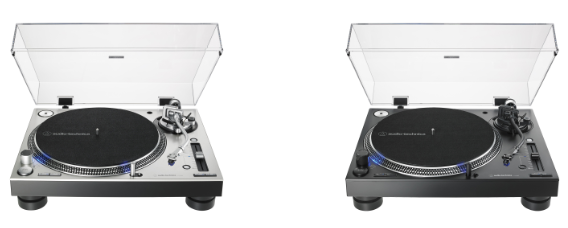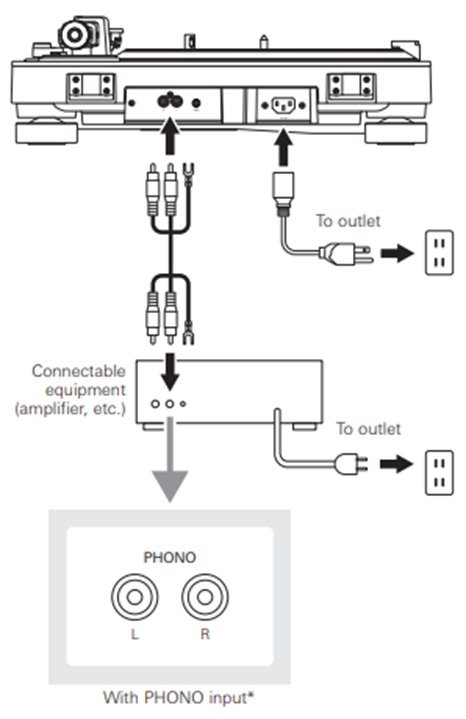
Carefully remove the turntable from the package and verify that all parts and accessories are present. You should have the following items:
- The turntable chassis
- Dust cover and dust cover hinges
- Aluminium record platter
- Felt record mat (slip mat)
- Headshell with pre-installed AT-XP3 cartridge
- Tonearm counterweight assembly with integrated tracking force gauge ring
- 45 RPM record adaptor
- Dual RCA audio cable with integrated ground wire
- AC power cord
- Quick start guide
- Setting up the turntable
Setting up the Turntable
Position the turntable on a level surface. If the surface is not level, the turntable may be levelled by adjusting the feet on the turntable. The feet thread into the bottom of the turntable chassis and are screwed all the way in for shipping purposes. With the aid of a bubble level (sold separately) adjust the feet as needed to level the turntable. Raise the height of one or more corners by supporting the weight of that corner of the turntable with one hand while unscrewing the foot in a clockwise direction with the other hand.
Assemble the dust cover
Install the dust cover hinges into the slots on the dust cover, but do not install the dust cover onto the turntable at this time. Set this aside for later.
To avoid the effects of vibrations and acoustic sound pressure, do not position the turntable on top of or near any loudspeakers.
Install the platter
Carefully place the aluminium record platter on the turntable’s centre spindle, making sure it fully seats on the spindle. Place the felt record mat on the platter.
Setting up the tonearm assembly
Install the headshell/cartridge assembly.
Remove the twist tie and temporarily secure the tonearm to its rest with the locking clamp.
Attach the headshell with the pre-installed cartridge by inserting the headshell into the tonearm socket. While holding the headshell in position, rotate the headshell locking ring counterclockwise (to the left). As the ring rotates, it pulls the headshell into its seated position. Hand-tighten the ring until it is snug.
Install the counterweight (with integrated stylus tracking force gauge ring)
With the tracking force gauge ring end of the counterweight facing toward the front of the turntable, attach the counterweight to the back of the tonearm by rotating the weight in a counterclockwise (to the left) direction. As the weight rotates, it will thread onto the arm. Thread the weight onto the arm about halfway at this time; final adjustments will be made in the next step.
Balancing the tonearm and setting the tracking force
Caution: Do not drag the cartridge’s stylus across the platter or record mat while adjusting the tonearm’s balance or setting the tracking force. Doing so may damage the stylus assembly!
Remove the cartridge’s clear plastic stylus protector by pulling it straight off the front of the cartridge. Try not to pull down on the protector, doing so may dislodge the stylus assembly from the cartridge body.
Make certain that the anti-skate adjustment is set to “0” (no compensation) before proceeding.
While gently holding the sides of the headshell to stabilise the tonearm, release the tonearm locking clamp to allow the tonearm to swing freely. Continue to stabilise the tonearm while rotating the counterweight on the rear of the arm in the direction needed to balance the tonearm in the horizontal plane. Check for balance by temporarily releasing the headshell after each adjustment of the weight. Ultimately, the arm should float freely just above the tonearm rest, not touch the rest. In other words, a properly balanced tonearm will be parallel to the turntable chassis. Once the tonearm is balanced, place the tonearm into the tonearm rest and secure it using the locking clamp. Be careful not to rotate the counterweight while doing this.
To set the proper stylus tracking force for the provided AT-XP3 cartridge, first locate the black tracking force gauge ring that is semi-attached to the front of the counterweight. Marked with numbers and lines indicating different tracking force values, the ring can be rotated independently of the weight. Without turning the counterweight itself, carefully rotate the ring only until the “0” on the ring lines up with the center-line marked along the top of the tonearm. Your tonearm is now properly balanced and calibrated so you can accurately set the tracking force for the stylus. The recommended tracking force for the provided AT-XP3 cartridge is 3.0 grams. To set the tracking force, rotate the counterweight, along with the ring, in the counterclockwise direction and stop when the “3” on the ring lines up with the center-line on top of the arm. Note that the ring turns with the weight as you are rotating the weight. The numbers on the ring should be going up in value as you rotate the counterweight if you are turning the weight in the right direction.
Set the anti-skate adjustment
Set the anti-skate adjustment to the same value as the tracking force, 3.0.
Setting up audio and power connections
The AT-LP140XP turntable provides a traditional unequalised PHONO level output. This makes it compatible with the PHONO input jacks found on many stereo amplifiers, stereo receivers and DJ mixers. A 1.4 m (4.6′) dual RCA audio cable with an integrated ground wire is provided for making the connection. The RCA cable’s red plug is the right (R) channel, and the white plug is the left (L) channel. For connection to devices that do not have PHONO input jacks on them, the installation of a separate phono pre-amplifier between the turntable and the device will be required.
Connecting to PHONO jacks
If your device has PHONO input jacks on it, simply connect the turntable to the jacks using the provided dual RCA audio cable. Attach the audio cables integrated ground wire to the ground lug on the device.
Connecting to AUX, AUDIO IN or other LINE level jacks
If your device does not have PHONO type input jacks, the turntable may be connected to other types of inputs such as AUX, AUDIO IN, LINE, CD, etc. by installing a separate phono preamplifier between the turntable and the device. Connect the turntable to the phono preamplifier, and the phono preamplifier to the device. Note that if the turntable is connected to any input other than a PHONO input without the aid of an inline phono preamplifier, you will have little to no sound at all through this input.
Connect to power and install the dust cover
After the audio connection is made, attach the included AC power cord to the AC power inlet on the rear of the turntable, then connect the opposite end of the cord to a convenient AC power outlet. Retrieve the dust cover and install on the hinges.
If you have any issues during the setup or have any follow-up questions, we invite you to contact us so that we can offer you further advice.
